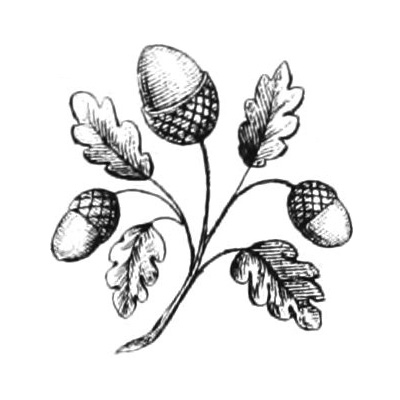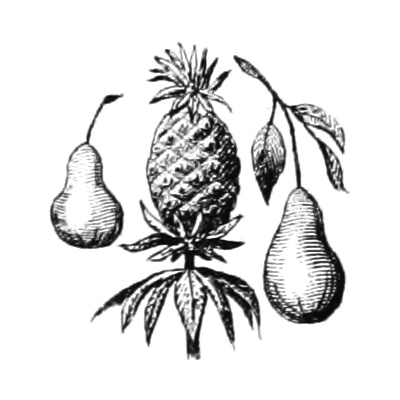- tree
TREE, Stem of, erased and sprouting. P. 45, f. 56. (ELVN)
TREE, Stock or Stump of, snagged and erased. i.d. (ELVN)
TREE, Stock of, jacent eradicated. i.d. f. 57. (ELVN)
TREE, Stem of, couped, eradicated, and sprouting. i.d. (ELVN)
TREE, Starved or Blighted, i.d. f. 58. (ELVN)
TREE. Trees in great variety are met with in Coat Armour, e.g. The Alder, Almond, Apple. Aspen, Ash, Banyan, Beech, Birch, Box, Cedar, Cherry, Cocoa, Cotton, Cypress, Date, Elm, Fir, Hawthorn, Linden or Lime, Mahogany, Oak, Olive, Orange, Palm, Pear, Pine, Pollard-Willow, Paradise (Tree of), Poplar, Salix, Savin, Thorn, Walnut, Willow, Yew, etc. See P. 45, f. 31 to 60, and P. 22, f. 7.
In blazoning a Tree you must observe in what condition it appears, whether spread, or blasted ; and what kind of 'Tree it is, whether bearing fruit ; if so, it is termed Fructed. If a part only is borne, that part must be named as Stem, Stock, or Stump, Branches, Fruit, Leaves. The Stem, Stock, or Stump, must be described, if standing, as “ erect ” ; if fallen, as “ jacent ” ; if torn up by the roots, as “ eradicated ” ; if shooting forth leaves, as “ sprouting, ” etc. P. 45, f. 56 and 57. A branch with fruit is said to be fructed ; if with leaves only, it is termed a branch ; when without leaves, it is said to be withered, f. 58 ; if torn off, it is called slipped. P. 44, f. 56. A branch, if fructed, is always supposed to consist of four leaves. P. 44, f. 53. If unfructed of nine leaves, i.e. three slips set together on one stem. A sprig should have live leaves, and a slip only three. P. 44, f. 52.
(ELVN)
Tree
Tree, (fr. arbre): the tree is a very common bearing in later heraldry, but is very rare, if used at all, in early arms. In the arms of Sir Rauf de CHEYNDUT the cheyne probably means only the acorn, as in the arms of MORIENS the leaves only of the mulberry-tree are intended. But in later arms several examples will be found, both of trees generally and special kinds of trees and shrubs(fr. arbustes). Amongst these are found the oak(fr. chкne), (the most frequent); apple(fr. pommier); orange(fr. oranger); fig(fr. figuier); ash(fr. frкne); elm(fr. orme and ormeau); hawthorn(fr. aubépin); holly(fr. houx); laurel(fr. laurier); maple; palm(fr. palmier); pine(fr. pin); fir(fr. sapin); cedar; cypress(fr. cyprès); poplar(fr. peuplier); willow(fr. saule); and yew. Also the leaves and branches of several other trees, e.g. beech(fr. hкtre); mulberry(fr. murier); olive(fr. olivier); walnut(fr. noyer); nut(fr. noisetier). (See Synopsis.)
In French arms, besides those noted above, have been observed, baume(balsam); buis(box); cormier(service-tree); chвtagnier(chestnut); aubier(sap-wood); gui(mistletoe); neflier(medlar); but no English examples of these have been observed.
When the term tree only is named without any adjunct, it may be considered to be that of the oak, and may be drawn like the example given under that term. But more frequently it is subjected to some special treatment, e.g. it may have the appearance of being torn up by the roots, to which the term eradicated(fr. arraché) is applied(and this is a better term than erased, which should only be applied to parts of animals). The tree is often trunked, i.e. truncated(fr. étкté), pollard(fr. écimé), or lopped(fr. écoté); or it may be couped, so that the section is seen in perspective, and in that case the term snagged should be applied. Again it may be withered(fr. sec); or it may be broken, or blasted, or without branches(fr. ébranché). A full-grown tree is said to be accrued. A tree may be fructed(fr. fruité), and this applied to the oak(q.v.) would signify with acorns(fr. englanté). When the trunk is a different tincture from the rest of the tree the French use the term fыté.
:«Argent, a tree growing out of a mount in base vert, in chief three mullets gules» – WATT, Scotland.
:«Argent, on a mount in base a branched tree vert» – BARETREY.
:«Gules, the stem and trunk of a tree eradicated as also couped, in pale, sprouting out two branches argent» – BOROUGH, Leicester.
:«Per pale argent and gules, a lion rampant of the first on the sinister side, supporting a tree eradicated proper on the dexter» – WINSTONE, co. Brecknock.
:«Gules, an oak-tree eradicated proper; crossing the stem and near the root a greyhound courant argent» – BOLGER, Arklow, Ireland.
:«Argent, an oak-tree erased proper; over all a fesse wavy azure» – NEAL.
:«On a mount a withered tree; in sinister a representation of a cherub's head with wind issuing therefrom towards the tree; on a chief an eagle displayed crowned with a celestial crown» – PIOZZI.
:«Argent, a tree in bend couped at the top and slipped at the bottom sable» – TANKE.
:«Argent, an arm proper, habited gules, issuing out from the side of the escutcheon and holding the lower part of a broken tree eradicated vert, the top leaning to the dexter angle» – ARMSTRONG, Scotland.
:«Coupé d'or et de gueules, а l'arbre sec au naturel brochant sur le tout» – BESCOT, Ile de France.
:«D'argent, а un murier(mulberry) de sinople fыté de sable; et un chef d'or chargé d'une tкte de Maure de sable tortillée d'argent» – MOREL, Burgundy.
Помимо дерева, часто исп. его части. Мы находми ствол (trunk, фр. tronc d'arbre), stock, stem, пень (stump, фр. souche) или body, в одном значении и исп. герольдами без рабора. Они обычно описаны как «couped», если это не подразумевается. Часто – «eradicated», «branches» (герб BOROUGH выше) или «slips» (герб STOCKDEN ниже).
Мы находим т.ж. термин « limb», обычно показанный «raguly» (сходен. возможно, с фр. noueux). Изображение должно исключить ошибочное смешение с fesse или bend raguly, его положение д.б. описано, по умолчанию – в столб.
Далее – ветви (branches, фр. branches), побеги (boughs, фр. rameaux), twigs, sprigs, slips и scrogs. Каждый термин имеет определённые отличия, но это не слишком строго соблюдается. Ветвь должна иметь трёх ответвлений (slips», но при наличии плодов достаёт и четырёх листьев; sprig должен иметь не менее пяти листьев, а slip – только три. В клювах у голубей как правило оливковые ветви. Многие термины, касающиеся дерева, применимы и к ветви. Что до «staved branches» (если это не ошибочное чтение starved = withered) – может означать lopped to represent staves.
:«Gules, the trunk of a tree eradicated and couped[otherwise snagged] in pale, sprouting two slips argent» – STOCKDEN, Leicester.
:«Vert, three trunks of trees raguly and erased argent» – STOCKTON, Ipswich, co. Suffolk.
:«Argent, three trunks of trees, couped under and above sable» – BLACKSTOCK, Scotland.
:«Argent, the trunk of an oak-tree sprouting afresh» – HERE.
:«De gueules, deux troncs écotés d'or passés en sautoir soutenant une tour donjonnée de deux tourelles d'argent» – LA SALLE DE PUYGERNAND, Auvergne.
:«Argent, three stocks[or stumps] of trees couped and eradicated sable» – RETOWRE.
:«Argent, three stocks of trees couped and eradicated sable, sprouting anew» – GEALE, Ireland.
:«Per fesse, argent and azure, a stock[or trunk] of a tree couped and eradicated in bend or» – AHLEN.
:«Argent, the stem of a tree couped and eradicated in bend proper» – HOLDSWORTH, Warwick.
:«Gules, the stem of a tree couped at both ends in bend or» – BRANDT.
:«Argent, a fesse embattled gules, in base a stump of a tree proper» – RICHARDS.
:«Argent, three stumps of trees couped and eradicated vert» – CORP.
:«Gules, a chevron between three stumps of trees or» – SKEWIS, co. Cornwall.
:«D'or, a trois souches de sable» – WATELET DE LA VINELLE, Flanders.
:«Argent, on a mount in base vert, the body of a tree sable, branched and leaved proper, between two lions rampant combatant gules» – BOYS.
:«Gules, the limb of a tree with two leaves in bend argent» – BESSE.
:«Argent, a limb of a tree raguled and trunked, with a leaf stalked and pendent on each side vert» – BOODE.
:«Sable, an eagle displayed argent, armed or, standing on the limb of a tree raguled and trunked of the second» – BARLOW.
:«Ermine, on a chevron sable, three withered branches argent» – FRESE.
:«D'argent, а la branche de frкne de sinople posée en bande» – BAUTHER.
:«De gueules, au saule[=willow] terrassé et étкté d'or, ayant six branches sans feuilles, trois a dextre trois a senestre; au chef cousu de France» – Ville de MONTAUBAN.
:«Argent, a fesse vairy or and azure between three doves proper, bearing in their beaks a branch vert» – BUCKLE, Warwick.
:«Argent, three staved branches slipped sable, two and one» – BLACKSTOKE.
:«Per fesse, argent and gules, a bird standing upon the top of a tree vert, with a bell hanging from a sinister bough, and over all in base a fish on its back[otherwise blazoned, a salmon in fesse], with a ring in the mouth» – City of GLASGOW.
:«Gules, three trefoils, the stalks embowed at the end, and fixed to a twig, slipped, lying fesswise argent» – BROMMEN.
:«Argent, three sprigs conjoined in base vert; on a chief gules a crescent between two mullets of the field» – CHAWDER, Scotland.
:«Argent, a slip of three leaves vert» – BROBROUGH.
:«Or, a chevron azure between two scrogs in chief, and a man's heart in base proper» – SCROGIE, Scotland.
:«Argent, three scrogs blasted sable» – BLASTOCK of that Ilk. [Cf. BLACKSTOCK above.]
– PARC
arbre — tree.
See the chapter on Common Emblems for a discussion on the use of trees in French civic heraldry. In the Glossary, I have given the botanical names for trees where it has been possible to distinguish them, although some cannot be exactly identified. Although the distinction between different trees in heraldry is often difficult, the blazon is us. exact, perhaps in order to preserve a local legend or to make a play on words regarding the derivation of the name of the commune, even if these are not always accurate as far as their etymology is concerned. FRGL


